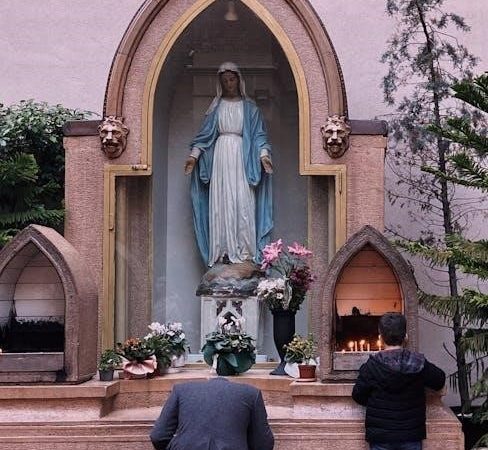vinayaka ashtothram pdf
Vinayaka Ashtothram PDF: A Comprehensive Guide
The Vinayaka Ashtothram is a sacred Hindu prayer dedicated to Lord Ganesha, revered as the remover of obstacles and the god of new beginnings. This comprehensive guide explores the Ashtothram, focusing on its availability in PDF format and its significance.
Overview of Vinayaka Ashtottara Shatanamavali
The Vinayaka Ashtottara Shatanamavali is a revered Hindu prayer comprising 108 names of Lord Ganesha, also known as Vinayaka. Lord Ganesha holds a prominent position in Hinduism as the remover of obstacles, the patron of arts and sciences, and the deity associated with auspicious beginnings. This sacred prayer, available in various formats including PDF, serves as a powerful tool for devotees seeking blessings and guidance.
Each name within the Ashtottara Shatanamavali encapsulates a unique aspect of Lord Ganesha’s divine attributes and qualities. Reciting these names with devotion is believed to invoke his divine presence, leading to the removal of obstacles, the attainment of success, and the bestowal of wisdom. The Ashtottara Shatanamavali is widely recited during religious ceremonies, festivals, and personal prayers, serving as a means to connect with the divine and seek blessings for overall well-being. The availability of the Vinayaka Ashtottara Shatanamavali in PDF format allows devotees to easily access and recite this sacred prayer anytime, anywhere, fostering a deeper connection with Lord Ganesha.
Significance of Lord Ganesha (Vinayaka)
Lord Ganesha, also known as Vinayaka, holds a paramount position in the Hindu pantheon. He is widely revered as the remover of obstacles, the god of wisdom, and the patron of arts and sciences. His blessings are sought at the beginning of any new venture or undertaking, ensuring success and prosperity. Lord Ganesha’s significance extends beyond his role as an obstacle remover; he is also considered the embodiment of intellect, knowledge, and auspiciousness.
His unique form, with an elephant head and a human body, symbolizes the integration of wisdom and practicality. The large ears signify attentiveness, the small mouth represents the importance of controlled speech, and the trunk embodies adaptability and efficiency. Lord Ganesha’s association with the Vinayaka Ashtothram further emphasizes his importance. The Ashtothram, a collection of 108 names, each representing a unique aspect of the deity, serves as a powerful tool for devotees to connect with and invoke his blessings. Reciting the Ashtothram is believed to remove obstacles, bestow wisdom, and grant overall well-being, solidifying Lord Ganesha’s significance in the lives of millions.
Vinayaka Ashtottara in Telugu PDF: Availability and Download
For Telugu-speaking devotees, the Vinayaka Ashtottara Shatanamavali is readily available in PDF format, facilitating easy access and recitation. Numerous websites and online repositories offer free downloads of the Telugu version of the Ashtottara, catering to the widespread demand for this sacred prayer. These PDFs typically contain the 108 names of Lord Ganesha in Telugu script, allowing devotees to follow along and chant with clarity and precision.
The availability of the Vinayaka Ashtottara in Telugu PDF format is a boon for those who prefer to read and recite the prayer in their native language. It ensures that the essence and meaning of each name are understood and appreciated, fostering a deeper connection with Lord Ganesha. Many websites also provide audio recordings of the Ashtottara being chanted in Telugu, further aiding devotees in learning the correct pronunciation and intonation. By searching online, devotees can easily find and download the Vinayaka Ashtottara Shatanamavali in Telugu PDF, enabling them to incorporate this powerful prayer into their daily spiritual practice. This accessibility ensures the continued reverence and propagation of Lord Ganesha’s divine names within the Telugu-speaking community.
Meaning and Interpretation of Selected Names
The Vinayaka Ashtottara Shatanamavali comprises 108 names, each representing a unique attribute, quality, or aspect of Lord Ganesha. Understanding the meaning and interpretation of these names enhances the devotion and connection one feels while reciting the Ashtottara. For instance, “Gajanana” refers to Ganesha’s elephant face, symbolizing wisdom and strength. “Vighnaharta” signifies the remover of obstacles, highlighting his role in clearing paths for success and prosperity.
“Vinayaka” itself means the supreme leader or master, emphasizing his divine authority. “Lambodara” describes his large belly, representing his ability to digest and assimilate all experiences, both good and bad. “Ekadanta” refers to his single tusk, symbolizing his ability to overcome duality and focus on a single purpose. Each name in the Ashtottara is a key to unlocking a deeper understanding of Ganesha’s multifaceted nature and his significance in Hindu mythology. By contemplating the meanings of these names, devotees can cultivate a stronger bond with the deity and invoke his blessings more effectively. The interpretations provide valuable insights into the spiritual essence of Lord Ganesha.
Benefits of Chanting Vinayaka Ashtottara
Chanting the Vinayaka Ashtottara is believed to bestow numerous benefits upon the devotee. Regular recitation is said to remove obstacles and difficulties from one’s life, paving the way for success in all endeavors. It is also believed to enhance wisdom, intelligence, and knowledge, making it particularly beneficial for students and those seeking intellectual growth. Furthermore, the Ashtottara is thought to bring prosperity, wealth, and abundance into the devotee’s life, ensuring financial stability and material well-being.
Beyond material benefits, chanting the Vinayaka Ashtottara can also lead to spiritual growth and inner peace. It helps to purify the mind, reduce stress, and promote a sense of calmness and tranquility. Devotees often report feeling a stronger connection to Lord Ganesha and experiencing a sense of divine grace and protection. The vibrations created by chanting the names are believed to positively influence the environment and create a harmonious atmosphere. It is a powerful tool for self-transformation and for invoking the blessings of Lord Ganesha for overall well-being and fulfillment. The practice fosters devotion, leading to spiritual enlightenment.
Languages Available for Vinayaka Ashtottara PDF
The Vinayaka Ashtottara, being a widely revered prayer, is available in PDF format in numerous languages to cater to a diverse audience of devotees. Sanskrit, the ancient language of Hinduism, is the original language in which the Ashtottara is composed, and PDFs are readily available for those who prefer to chant in the traditional form; Furthermore, recognizing the need for accessibility, the Ashtottara has been translated into various Indian languages, including Telugu, Kannada, Tamil, Malayalam, Hindi, Gujarati, Bengali, and Oriya. This allows devotees to connect with the prayer in a language they understand, enhancing their devotional experience.
Beyond Indian languages, versions of the Vinayaka Ashtottara PDF may also be found in English and other international languages. These translations aim to make the prayer accessible to a global audience, allowing individuals from different cultural backgrounds to appreciate and benefit from the wisdom and blessings associated with Lord Ganesha. The availability of the Ashtottara in multiple languages underscores its universal appeal and the desire to share its spiritual benefits with everyone. The PDF format ensures easy access and portability, enabling devotees to chant the prayer anytime, anywhere.
Sanskrit Versions
The Sanskrit version of the Vinayaka Ashtottara PDF holds paramount importance as it represents the original and traditional form of the prayer. Rooted in the ancient Vedic scriptures, the Sanskrit rendition carries a unique spiritual resonance and is considered highly auspicious for chanting. Many devotees prefer reciting the Ashtottara in Sanskrit due to its precise phonetic structure and the belief that the vibrations produced during recitation have a profound impact on the mind and body. The Sanskrit PDF versions often include the original Devanagari script, allowing for accurate pronunciation and intonation.
These PDFs may also provide transliterations in other scripts, such as English, to aid those unfamiliar with Devanagari. Furthermore, some Sanskrit versions offer detailed explanations of each name’s meaning, providing deeper insight into Lord Ganesha’s attributes and significance. Availability of Sanskrit PDFs ensures the preservation and accessibility of this sacred prayer for future generations. Devotees can easily download these versions and incorporate them into their daily spiritual practices. The meticulous rendering in digital format ensures that the essence of the prayer remains intact, empowering individuals to connect with the divine through the power of Sanskrit.
Telugu Versions
The Telugu version of the Vinayaka Ashtothram PDF is widely sought after by devotees in Andhra Pradesh and Telangana, where Telugu is the primary language. These PDFs provide the Ashtottara in the Telugu script, making it accessible and easy to recite for native Telugu speakers. The Telugu versions often include clear and precise transliterations, ensuring accurate pronunciation and understanding of each name of Lord Ganesha. Many websites and online resources offer free downloads of the Vinayaka Ashtottara PDF in Telugu, catering to the devotional needs of the Telugu-speaking community. These PDFs may also feature additional content, such as the meaning of each name in Telugu, enhancing the devotee’s comprehension and connection with the prayer.
Furthermore, some Telugu versions include audio recordings of the Ashtottara being recited, allowing devotees to learn the correct pronunciation and intonation. The availability of the Vinayaka Ashtottara in Telugu PDF format ensures that this sacred prayer remains an integral part of the religious and cultural practices of the Telugu-speaking population. The ease of access and user-friendly format of these PDFs make it convenient for devotees to incorporate the Ashtottara into their daily prayers and rituals. This digital accessibility helps preserve and promote the rich devotional heritage associated with Lord Ganesha in the Telugu-speaking regions.
Kannada Versions
The Kannada version of the Vinayaka Ashtothram PDF is essential for devotees in Karnataka, where Kannada is the dominant language. These PDFs present the Ashtottara in the Kannada script, facilitating easy reading and recitation for Kannada-speaking individuals. The Kannada versions typically feature accurate transliterations, ensuring proper pronunciation and comprehension of each of Lord Ganesha’s names. Numerous websites and online platforms offer complimentary downloads of the Vinayaka Ashtottara PDF in Kannada, catering to the religious requirements of the Kannada-speaking populace. These PDFs may also contain supplementary materials, such as the meaning of each name in Kannada, enriching the devotee’s understanding and relationship with the prayer.
Moreover, some Kannada versions include audio recordings of the Ashtottara being chanted, enabling devotees to learn the correct pronunciation and intonation. The accessibility of the Vinayaka Ashtottara in Kannada PDF format guarantees that this sacred prayer remains a vital component of the religious and cultural traditions of the Kannada-speaking community. The user-friendly format and ease of access of these PDFs make it convenient for devotees to integrate the Ashtottara into their regular prayers and rituals. This digital accessibility assists in preserving and promoting the abundant devotional heritage associated with Lord Ganesha in the Kannada-speaking regions.
Other Indian Language Versions
Beyond Sanskrit, Telugu, and Kannada, the Vinayaka Ashtothram is accessible in several other Indian languages, catering to the diverse linguistic landscape of India. These versions enable devotees from various regions to connect with Lord Ganesha through their native tongues, enhancing the personal and emotional significance of the prayer. For example, the Ashtothram can be found in Tamil, Malayalam, Gujarati, Bengali, Oriya, and Hindi, among others. Each version is meticulously transcribed to ensure accurate pronunciation and understanding.
The availability of Vinayaka Ashtothram PDFs in these languages fosters inclusivity and accessibility for devotees nationwide. Online platforms and religious websites offer free downloads of these PDFs, often accompanied by audio recordings and translations, to facilitate proper recitation and comprehension. These resources empower individuals to integrate the Ashtothram into their daily prayers and rituals, regardless of their linguistic background. Furthermore, the widespread availability of these versions promotes the preservation and propagation of the cultural and spiritual heritage associated with Lord Ganesha across different regions of India. By offering the Ashtothram in multiple languages, devotees can experience a deeper connection with the deity and enrich their spiritual journey.
How to Recite Vinayaka Ashtottara
Reciting the Vinayaka Ashtottara is a deeply spiritual practice that can bring numerous benefits to devotees. To begin, find a quiet and clean space where you can focus without distractions. It is ideal to perform the recitation in the morning or evening, preferably after a bath or cleansing ritual. Light a lamp or incense to create a serene atmosphere.
Before starting, take a few deep breaths to center yourself and clear your mind. Hold a picture or idol of Lord Ganesha in front of you to enhance your focus and devotion. Begin by chanting a simple prayer or mantra to invoke Lord Ganesha’s presence and blessings. Then, slowly and deliberately recite each of the 108 names of Lord Ganesha from the Ashtottara. If you are using a PDF version, ensure it is clear and easy to read.
Pay attention to the pronunciation and meaning of each name. Reciting with understanding and devotion amplifies the power of the prayer. After completing the recitation, offer your gratitude to Lord Ganesha for his blessings. Conclude with a final prayer or mantra, expressing your devotion and seeking his continued guidance. Regular recitation of the Vinayaka Ashtottara can help remove obstacles, promote well-being, and deepen your spiritual connection with Lord Ganesha.
Proper Pronunciation and Intonation
Accurate pronunciation and intonation are crucial when reciting the Vinayaka Ashtottara. Each of the 108 names of Lord Ganesha carries a specific vibration and energy, and mispronouncing them can diminish the efficacy of the prayer. Therefore, it’s essential to pay close attention to the phonetic sounds of each syllable.
Start by listening to recordings of the Ashtottara recited by knowledgeable individuals or scholars. This will help you familiarize yourself with the correct pronunciation and rhythm. Pay attention to the stress placed on different syllables and the overall flow of the recitation. The Sanskrit language, in which the Ashtottara is traditionally composed, has specific rules of pronunciation that must be followed.
When reciting, speak clearly and deliberately, ensuring that each syllable is distinct. Avoid rushing through the names, as this can lead to errors in pronunciation. Intonation, or the rise and fall of your voice, also plays a significant role in conveying the meaning and emotion of the prayer. Recite with reverence and devotion, allowing your voice to reflect the sacredness of the names. If you are unsure about the pronunciation of a particular name, consult with a knowledgeable person or refer to reliable online resources. With practice and dedication, you can master the proper pronunciation and intonation of the Vinayaka Ashtottara, enhancing the power and impact of your prayers.





